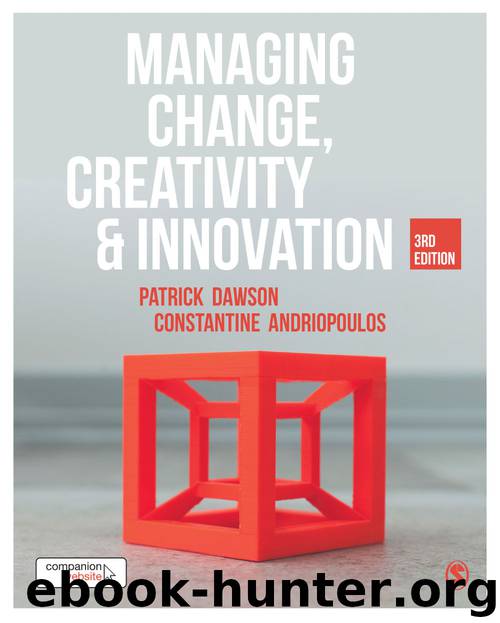Managing Change, Creativity and Innovation by Patrick Dawson & Costas Andriopoulos

Author:Patrick Dawson & Costas Andriopoulos [Dawson, Patrick]
Language: eng
Format: azw3
Publisher: SAGE Publications
Published: 2017-03-20T04:00:00+00:00
Chapter Review Questions
The questions listed below relate to the chapter as a whole and can be used by individuals to further reflect on the material covered, as well as serving as a source for more open group discussion and debate.
In a foreword to Bushe and Marshak’s (2015) Dialogic Organization Development, Edgar Schein (2015) claims that: ‘Dialogic Organizational Development (OD) could not have arrived at a better time. The assumptions underlying it and some of the goals for social change and improvement that it articulates not only build on an important historical legacy but reinforce those aspects of OD that will be most need in the future.’ Discuss and assess this claim.
Identify and discuss the key underlying principles of the ‘new’ dialogical organizational development approach to organizational change.
Construct a table that compares and contrasts the similarities and differences between diagnostic and dialogical OD.
Explain what you understand by the term ‘the art and practice of the learning organization’ and outline some of the main strengths and weaknesses of this approach.
Outline the key components of the change kaleidoscope framework and evaluate the practical value of the approach for managing organizational change.
What are the advantages and disadvantages of Jabri’s model that combines Lewin’s three stages of change with a more process-oriented dialogical approach?
Provide a critical assessment of appreciative inquiry, setting out the advantages and disadvantages of the approach for: (a) understanding processes of change; (b) planning processes of change; and (c) enabling improvisational and emergent change to occur.
In drawing on a familiar change example, evaluate which of the frames or models discussed in this chapter would best align and explain the reasons why.
Reflect on the notions of objective and subjective, then consider whether there is a clear division between the two or whether the boundaries blur.
Download
This site does not store any files on its server. We only index and link to content provided by other sites. Please contact the content providers to delete copyright contents if any and email us, we'll remove relevant links or contents immediately.
Hit Refresh by Satya Nadella(8854)
The Compound Effect by Darren Hardy(8508)
Change Your Questions, Change Your Life by Marilee Adams(7372)
Nudge - Improving Decisions about Health, Wealth, and Happiness by Thaler Sunstein(7242)
The Black Swan by Nassim Nicholas Taleb(6764)
Deep Work by Cal Newport(6563)
Daring Greatly by Brene Brown(6223)
Rich Dad Poor Dad by Robert T. Kiyosaki(6175)
Principles: Life and Work by Ray Dalio(5961)
Man-made Catastrophes and Risk Information Concealment by Dmitry Chernov & Didier Sornette(5647)
Playing to Win_ How Strategy Really Works by A.G. Lafley & Roger L. Martin(5499)
Digital Minimalism by Cal Newport;(5389)
Big Magic: Creative Living Beyond Fear by Elizabeth Gilbert(5351)
The Myth of the Strong Leader by Archie Brown(5237)
The Slight Edge by Jeff Olson(5200)
Discipline Equals Freedom by Jocko Willink(5157)
The Motivation Myth by Jeff Haden(5003)
Stone's Rules by Roger Stone(4857)
The Laws of Human Nature by Robert Greene(4773)
